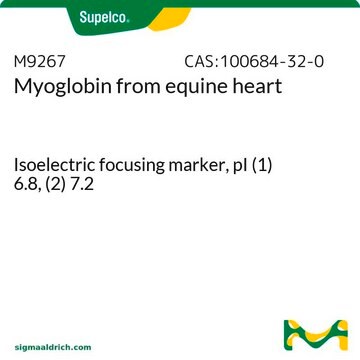C2867
Cytochrome c from equine heart
BioUltra, ≥99% (SDS-PAGE), powder, suitable for mammalian cell culture
Synonim(y):
CYC, CytC, Cytochrome c from horse heart
About This Item
Polecane produkty
pochodzenie biologiczne
horse heart
linia produktu
BioUltra
Próba
≥99% (SDS-PAGE)
Postać
powder
masa cząsteczkowa
12,384
warunki przechowywania
(Tightly closed Dry)
metody
cell culture | mammalian: suitable
rozpuszczalność
water: 10 mg/mL, dark red-brown
numer dostępu UniProt
temp. przechowywania
−20°C
informacje o genach
horse ... CYCS(100053958)
Szukasz podobnych produktów? Odwiedź Przewodnik dotyczący porównywania produktów
Powiązane kategorie
Opis ogólny
Research area: Apoptosis
Zastosowanie
Działania biochem./fizjol.
Uwaga dotycząca przygotowania
Inne uwagi
Zastosowanie
Kod klasy składowania
11 - Combustible Solids
Klasa zagrożenia wodnego (WGK)
WGK 3
Temperatura zapłonu (°F)
Not applicable
Temperatura zapłonu (°C)
Not applicable
Środki ochrony indywidualnej
Eyeshields, Gloves, type N95 (US)
Certyfikaty analizy (CoA)
Poszukaj Certyfikaty analizy (CoA), wpisując numer partii/serii produktów. Numery serii i partii można znaleźć na etykiecie produktu po słowach „seria” lub „partia”.
Masz już ten produkt?
Dokumenty związane z niedawno zakupionymi produktami zostały zamieszczone w Bibliotece dokumentów.
Klienci oglądali również te produkty
Chromatograms
application for HPLCapplication for HPLCapplication for HPLCNasz zespół naukowców ma doświadczenie we wszystkich obszarach badań, w tym w naukach przyrodniczych, materiałoznawstwie, syntezie chemicznej, chromatografii, analityce i wielu innych dziedzinach.
Skontaktuj się z zespołem ds. pomocy technicznej







